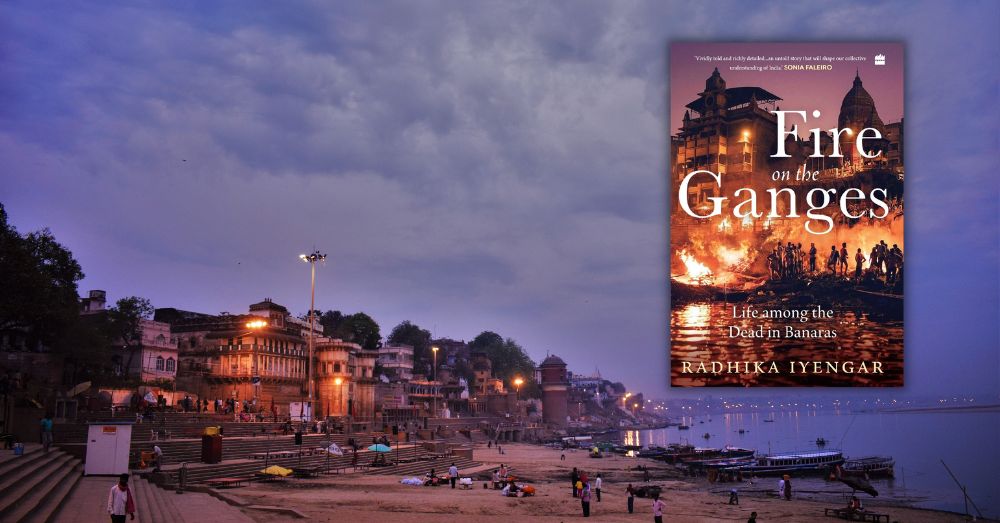Radhika Iyengar’s Fire on the Ganges is a descriptive account of her interactions and interviews with people from Banaras’s Dom community – a Dalit caste group that is ritually mandated to be corpse burners under Vedic Hinduism. More specifically, the book delves deep into the aspirations, challenges, and trauma of the people Iyengar talked to between 2015 and early 2023, especially those working at the city’s Manikarnika Ghat.
To begin with, the book is, of course, a characterisation of the Dom people that Iyengar interviewed during her research. By deploying a narration style that puts the oppressed at the centre of her words, Iyengar can cover a plethora of topics, which she very ably does. For instance, throughout this 320-pager, the chapters’ themes range across a broad spectrum, covering casteism, poverty, inter-caste matrimony, misogyny, workers’ rights, environmental pollution, and the littlest of bits that fill up an average Dom’s life. However, in addition to this descriptive account, the book reveals itself to be deeply engaged with the idea of death – and for good reason.
Death as a Central Theme
Given the Dom community’s customary role as corpse burners in Hinduism, their interaction with death, in different shapes and styles, forms a core part of their lived experience. By choosing this experience of witnessing death as a central idea in her book, Iyengar sets an effective foundation for the lives of the people she talks of.
The book’s name, highlighting a fire on the Ganga, alludes to the open-air corpse burning that signifies the last rites in Hinduism. Through frank descriptions of the final processes, the ailments that accompany them (alcoholism, substance abuse, etc.), and the day-to-day hierarchies that permeate the life of, say, a Dom woman or a Dom child, Radhika exposes her readers to the jarring realities of an oppressed people. More than that, though, she does it in a manner that doesn’t elicit shock, instead evoking empathy, which brings me to my thoughts on her writing style.
Lyrical Writing Style
In addition to being an extraordinarily detailed and well-described account of the Doms’ lives, what also enables Iyengar to capture my attention is her way with words. Intertwining personal statements with relevant background material makes sure that I am reading her thoughts just the way she intends me to, which makes me feel more involved in their meanings and usage.
By deploying succinctly weaved phrases at the right places, she switches deftly from grim descriptions to ironic observations, almost making sure that mere curiosity to know more would be enough to keep me going. For example, between paragraphs depicting the busy and bustling lives of people connected to Manikarnika Ghat, she does not fail to highlight for the reader: “In the land of the dead, there is life all around.” Similarly, to underline the importance of labour at the death-filled Ghats, she wittily remarks: “Almost everything is reclaimed from the dead to make a living.”
For me, this seemingly effortless use of metaphors serves a dual purpose. Firstly, it intrigues readers who, otherwise, might not have enjoyed a typical anthropological account of this depth, more so given the grief and trauma it conveys. Secondly, placed at strategically appropriate points, these summarisations force the reader to pause and contemplate the words that they have just rushed by. It barely cares for subtleties and instead makes sure that you, the reader – most likely an upper-caste person, understand precisely what Iyengar’s characters and through them, she wants you to understand. This ability to be articulate while ensuring that the realities of the oppressed’s lives do not get diluted left me wanting to read more.
Of Hope and Resilience
Lastly, as some of the book’s reviews also highlight, a recurring theme throughout is that of hope. Many of Iyengar’s characters – for instance, Bhola, a young adult who manages to escape his short-lived future of corpse burning and work for a company in Chennai, or Dolly, a widow who manages to become the community’s first woman entrepreneur – are pillars of resilience in the face of inhuman suffering.
More importantly, unlike some of her contemporaries, she doesn’t generalise their experiences quite easily. She dedicates enough time and words to nuance their journeys, their motivations, their trauma, their conflicts, and their successes.
In the end, then, Fire on the Ganges is an informative, insightful, and moving piece of literature that is passionately researched, humbly captured, and painfully multifaceted. Iyengar’s attempt at capturing caste in one of its most gruesome forms makes an impactful point, if nothing else. It reminds us, once again, that the caste system’s ability to transform itself, even by appropriating something as complex as death, is why it continues to thrive.
This book has been published by Harper Collins. Follow them on YKA here.
